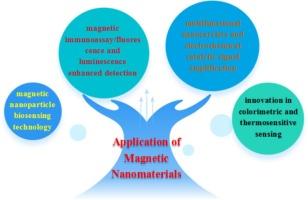Application of magnetic nanomaterials in virus detection: A mini-review
IF 4.9
2区 化学
Q1 CHEMISTRY, ANALYTICAL
引用次数: 0
Abstract
The swift and precise identification of viral pathogens plays a pivotal role in epidemic containment and public health protection. With the rapid development of nanotechnology, the application of magnetic nanomaterials (MNMs) in the epidemiological research field is becoming increasingly widespread. MNMs have emerged as powerful tools in virus detection, prevention, and treatment. Their unique magnetic properties, excellent stability, good biocompatibility, high specific surface area, and ease of functionalization make them highly suitable for these applications. These characteristics also provide new ideas and innovative methods for combating viruses. This mini-review highlights the recent advancements in applying MNMs for virus detection. It focuses on their roles in magnetic nanoparticle biosensing technology, magnetic immunoassay/fluorescence and luminescence enhanced detection, multifunctional nanocarriers and electrochemical catalytic signal amplification. The review also covers innovations in colorimetric and thermosensitive sensing. We also explored the obstacles and potential advancements of MNMs in this research area.

磁性纳米材料在病毒检测中的应用综述
快速、准确地鉴定病毒病原体对疫情防控和公众健康保护具有重要作用。随着纳米技术的飞速发展,磁性纳米材料在流行病学研究领域的应用日益广泛。纳米颗粒已成为病毒检测、预防和治疗的有力工具。其独特的磁性、优异的稳定性、良好的生物相容性、高比表面积和易于功能化使其非常适合这些应用。这些特点也为病毒防治提供了新的思路和创新的方法。这篇小型综述重点介绍了应用纳米颗粒进行病毒检测的最新进展。重点介绍了它们在磁性纳米粒子生物传感技术、磁性免疫分析/荧光和发光增强检测、多功能纳米载体和电化学催化信号放大等方面的作用。综述还涵盖了比色法和热敏传感的创新。我们还探讨了MNMs在这一研究领域的障碍和潜在的进展。
本文章由计算机程序翻译,如有差异,请以英文原文为准。
求助全文
约1分钟内获得全文
求助全文
来源期刊

Microchemical Journal
化学-分析化学
CiteScore
8.70
自引率
8.30%
发文量
1131
审稿时长
1.9 months
期刊介绍:
The Microchemical Journal is a peer reviewed journal devoted to all aspects and phases of analytical chemistry and chemical analysis. The Microchemical Journal publishes articles which are at the forefront of modern analytical chemistry and cover innovations in the techniques to the finest possible limits. This includes fundamental aspects, instrumentation, new developments, innovative and novel methods and applications including environmental and clinical field.
Traditional classical analytical methods such as spectrophotometry and titrimetry as well as established instrumentation methods such as flame and graphite furnace atomic absorption spectrometry, gas chromatography, and modified glassy or carbon electrode electrochemical methods will be considered, provided they show significant improvements and novelty compared to the established methods.
 求助内容:
求助内容: 应助结果提醒方式:
应助结果提醒方式:


